Camel Facts
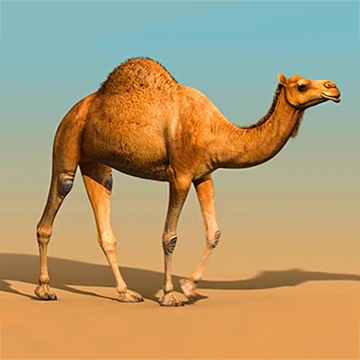
Contents
What is a Camel?
Camels are large animals with a humped back, long legs, flat feet, long curved necks, and big-lipped snouts. These remarkable creatures can withstand scorching heat, go for weeks without water, and survive on minimal food, making them one of nature’s most impressive desert dwellers.
There are two species of camel:
• Dromedary Camels (Camelus dromedarius) – One hump.
• Bactrian Camels (Camelus bactrianus) – Two humps.
Dromedary Camel (One Hump Camel)
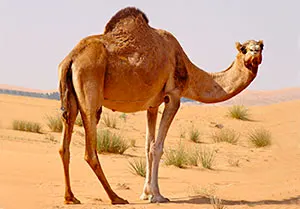
Dromedary camels, also known as Arabian camels, are the tallest of all camel species is easily recognized by their single hump. They vary in colour from dark brown to almost white and have short fur, except for thick patches on their throat, shoulders, and hump.
• Height: Males: 1.8–2 m (5.9–6.6 ft); Females: 1.7–1.9 m (5.6–6.2 ft)
• Weight: Males: 400–600 kg (880–1,320 lbs); Females: 300–540 kg (660–1,190 lbs)
• Population: About 95% of the world’s camels are dromedaries.
• Habitat: Originally from the Middle East and Africa, now found in India, Australia, and the USA.
Bactrian Camel (Two Hump Camel)
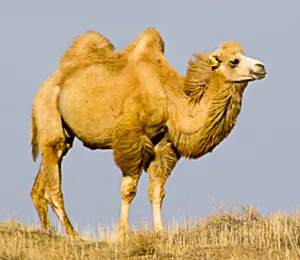
Bactrian camels, also known as Mongolian camels, can be identified by their distinctive twin humps. Native to Central Asia, they are built for harsh, cold climates. Unlike their dromedary cousins, they have thick fur, shorter legs, and a more robust build.
• Height: 1.8–2.3 m (5.9–7.5 ft) at the shoulder
• Weight: Up to 1,000 kg (2,200 lbs)
• Population: About 5% of camels worldwide
• Wild Population: Less than 1,000, classified as endangered.
• Habitat: Originally Central Asia, but are also found in China, India, Australia and the USA.
Camel's Special Adaptations
Camels have evolved several incredible adaptations to thrive in desert environments:
• Triple-layered eyelids & long lashes protect their eyes from sandstorms.
• Can close their nostrils to keep out blowing sand.
• Small and rounded ears with hair inside and out to prevent sand from entering their ears.
• Thick lips & tough mouths allow them to eat thorny plants.
• Sweat only at high temperatures (above 41°C/105°F) to conserve water.
• Oval-shaped red blood cells prevent dehydration by ensuring smooth circulation.
• Can lose up to 30% of body water without suffering dehydration.
• Hump stores fat and nearly disappears and flops over and nearly disappears when the fat store in it is used up.
Other Interesting Camel Characteristics
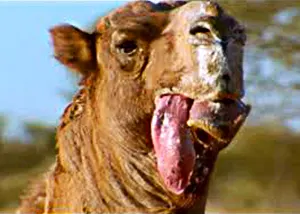
• Their incisors and canine teeth grow throughout life.
• Male camels foam at the mouth when excited.
• They inflate their soft palate into a dangling pink sac to attract females, often mistaken for their tongue.
• Camels spit when provoked, but they’re more like 'flingers.' They burp up stomach contents, mix them with saliva, and fling the foul-smelling mess from their lips.
• A Camel's height is measured at the shoulders, because the height of the hump varies, depending on the fat stored inside it.
• The camel has long, powerful legs with large two-toed feet that have thick, flexible footpads that help it walk on sand but offer little grip on mud or slippery surfaces.
How A Camel Walks and Runs
Camel Walking Video
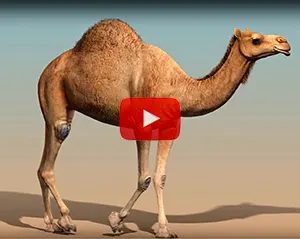
Camels move in a distinctive pacing gait, where both legs on one side move forward simultaneously, creating a swaying, rocking motion. This helps them walk long distances efficiently.
They can:
• Walk up to 160 km (99 miles) per day
• Run at speeds of 40 km/h (25 mph) for long distances.
• Sprint at 67 km/h (42 mph) for short bursts.
Camel Habitat & Distribution
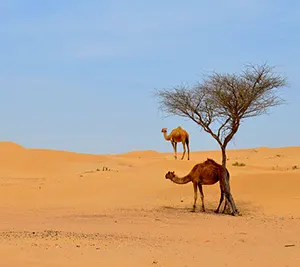
Photo: Camels in the desert
Camels inhabit some of the most extreme environments on Earth, including:
• Deserts & steppes of the Middle East, India, Pakistan, Afghanistan, and Central Asia.
• In Extreme Temperatures ranging from -29°C (-20°F) to 49°C (120°F).
• They prefer flat sandy environments. During winter, camels prefer open plains, salt marshes, and lakes. In summer, they prefer dense bush environments with trees to shade them from the blistering heat.
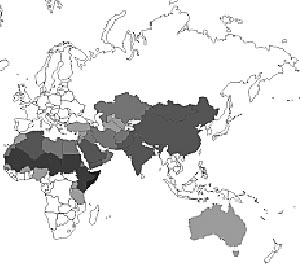
Photo: Diagram of distribution of camels worldwide
The world's largest population of wild camels live in central Australia's deserts. These include the Great Sandy, Gibson, Great Victoria, and Simpson deserts of Western Australia, the Northern Territory, western Queensland, and northern South Australia – an area of 3.3 million sq km.
What Do Camels Eat?
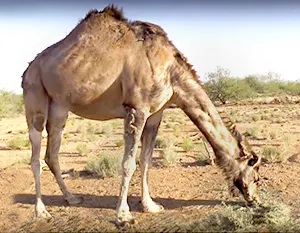
Photo: Camel feeding on desert scrubs
Camels are not picky eaters and consume a variety of plant material, such as grasses, leaves, twigs, cacti and saltbushes. It is claimed that a starving camel will eat almost anything including bones, ropes, leather products, and even canvas tents.
How Long Can a Camel Go Without Water?
A camel can survive for a week without water and can drink up to 145 litres (38 gallons) in one session. Unlike most animals, camels store energy in their humps as fat, which they metabolize for water and nutrients when needed.
Camels feed for 6-8 hours a day and ruminate (chew cud) for another 6-8 hours.
When food and water become scarce, the camel extracts energy and water from fat stored in its hump. The longer a camel goes without eating or drinking, the more visibly deflated its hump becomes.
Camel Reproduction & Life Cycle
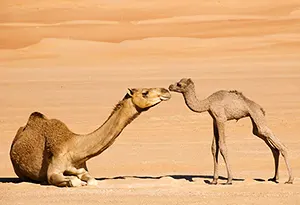
Photo: Camel mother and baby
A camel gives birth to a single calf about 12-14 months after mating.
• Gestation Period:12-14 months
• Birth: Usually a single calf; twins are rare.
• Newborns: Born without humps, which develop as they grow.
The new calf can walk within half an hour.
• Weaning: 10-18 months
• Maturity: Around 7 years old
• Lifespan: 40-50 years
Unfortunately, about 30% of camel calves don’t survive infancy, often due to death caused by aggressive male camels.
Camel Predators and Threats
Because of their large size and the arid environments in which they live, camels have no natural predators. However, they face threats from:
• Extreme drought and food shortages
• Infanticide by dominant males
• Government culling programs
• Harvesting for meat and pet food
25 Fascinating Camel Facts
- Camels do NOT store water in their humps – it’s fat!
- They can drink up to 145 litres (38 gallons) of water at once.
- A camel's blood cells are oval-shaped, allowing better circulation during dehydration.
- Camels can survive with a 30% body water loss, while humans perish at 15%.
- They can adjust their body temperature to conserve water.
- Camels have two sets of eyelids and long lashes to protect against sand.
- Their nostrils trap moisture, minimizing water loss.
- Camels can eat thorny plants without injury due to tough mouths.
- Their lips are split in two, making them expert foragers.
- They can go weeks without drinking in cool weather.
- Camels only sweat when their body reaches 41°C (106°F).
- A camel’s hump shrinks when it uses up its fat reserves.
- Baby camels are born without humps!
- Camels’ thick fur insulates them against heat and cold.
- Their long legs keep them away from hot desert sand.
- Camels foam at the mouth during mating season.
- They spit regurgitated stomach contents as a defence.
- Camels can run 40 km/h (25 mph) for long distances.
- The largest wild camel population is in Australia.
- Wild Bactrian camels are critically endangered.
Learn More About Australia's Incredibly Quirky Animals
All Rights Reserved. (Last Updated: Mar 17, 2025)